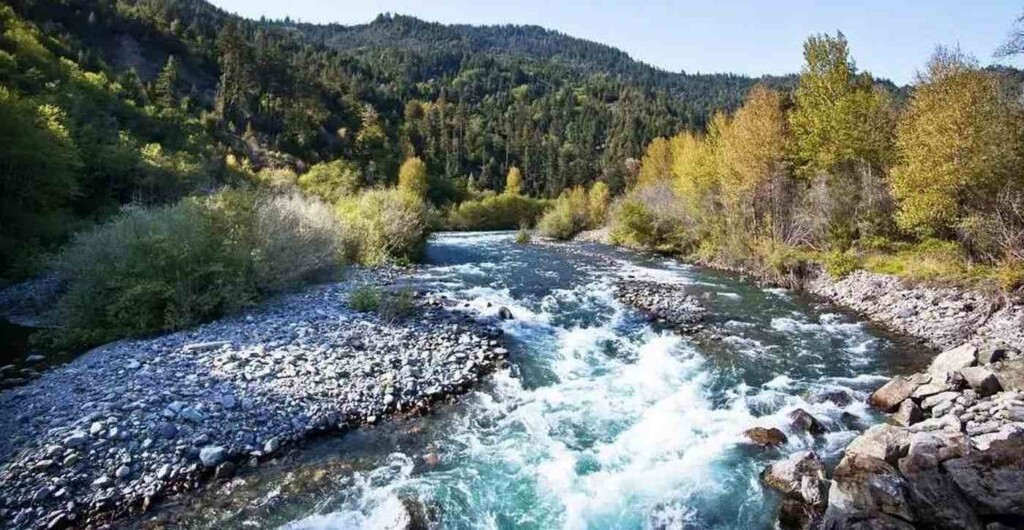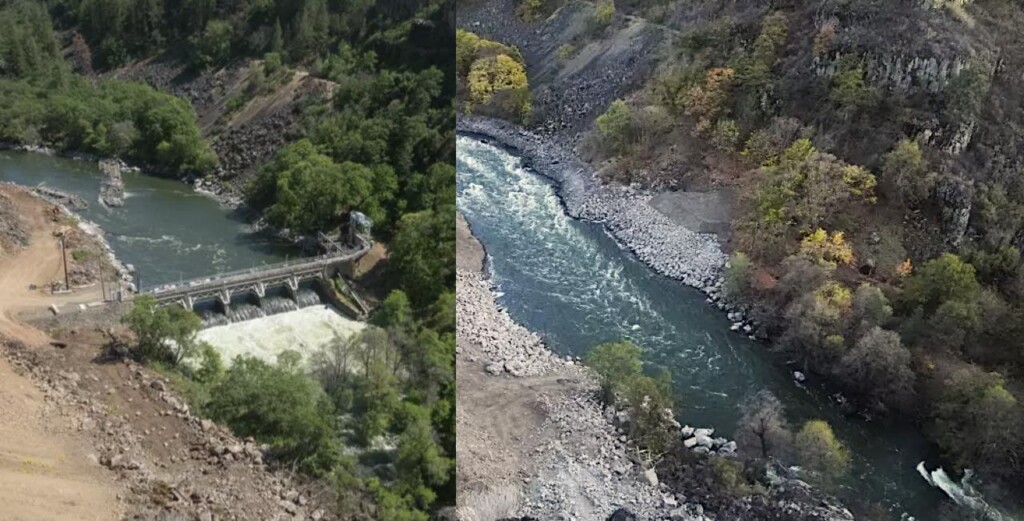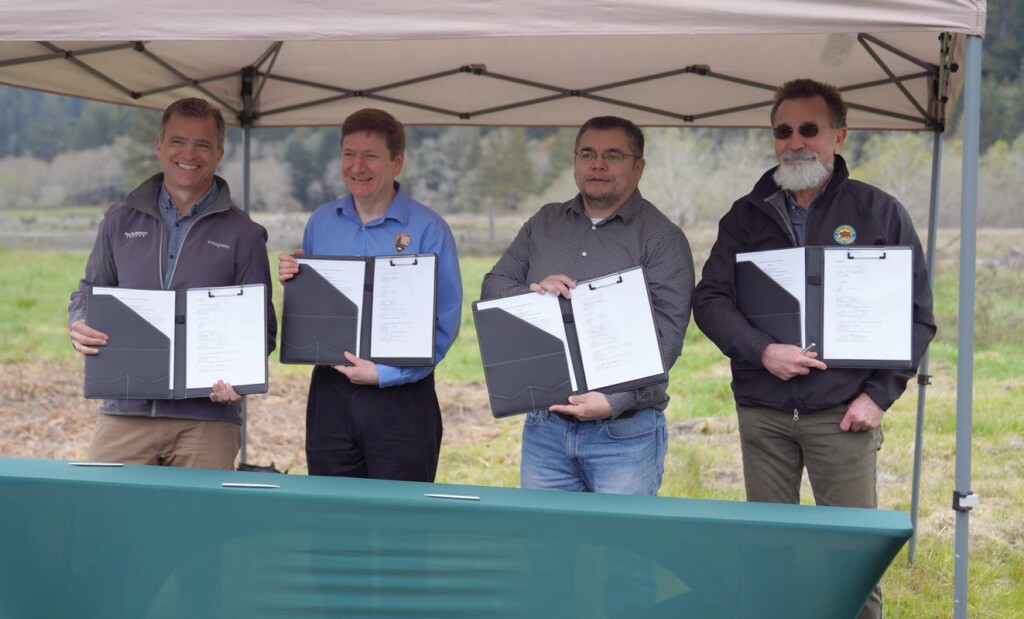 Blue Creek – credit, Cindy M. Diaz/Western Rivers Conservancy
Blue Creek – credit, Cindy M. Diaz/Western Rivers ConservancyIn Northern California, a native American tribe is celebrating the return of ancestral lands in one of the largest such transfers in the nation’s history.
Through a Dept. of the Interior initiative aiming to bring indigenous knowledge back into land management, 76 square miles east of the central stretch of the Klamath River has been returned to the Yurok tribe.
Sandwiched between the newly-freed Klamath and forested hillsides of evergreens, redwoods, and cottonwoods, Blue Creek is considered the crown jewel of these lands, though if it were a jewel it wouldn’t be blue, it would be a giant colorless diamond, such is the clarity of the water.
It’s the most important cold-water tributary of the Klamath River, and critical habitat for coho and Chinook salmon. Fished and hunted on since time immemorial by the Yurok and their ancestors, the land was taken from them during the gold rush before eventually being bought by timber companies.
Barry McCovey Jr., director of the Yurok Tribal Fisheries Department, remembers slipping past gates and dodging security along Blue Creek just to fish up a steelhead, one of three game fish that populate the river and need it to spawn.
Profiled along with the efforts of his tribe to secure the land for themselves and their posterity, he spoke to AP about the experience of seeing plans, made a decade ago, come to fruition, and returning to the creek on which he formerly trespassed as a land and fisheries manager.
“To go from when I was a kid and 20 years ago even, from being afraid to go out there to having it be back in tribal hands … is incredible,” he said.
Part of the agreement is that the Yurok Tribe would manage the land to a state of maximum health and resilience, and for that the tribe has big plans, including restoring native prairie, using fire to control understory growth, removing invasive species, restoring native fish habitat, and undoing decades of land-use changes from the logging industry in the form of culverts and logging roads.
“And maybe all that’s not going to be done in my lifetime,” said McCovey. “But that’s fine, because I’m not doing this for myself.”
The Yurok Tribe were recently at the center of the nation’s largest dam removal, a two decades-long campaign to remove a series of four hydroelectric dams along the Klamath River. Once the West Coast’s third-largest salmon run, the Klamath dams substantially reduced salmon activity.
 Klamath River flows freely, after Copco-2 dam was removed in California – Courtesy of Swiftwater Films
Klamath River flows freely, after Copco-2 dam was removed in California – Courtesy of Swiftwater FilmsCompleted last September, the before and after photographs are stunning to witness. By late November, salmon had already returned far upriver to spawn, proving that instinctual information had remained intact even after a century of disconnect.
“Seeing salmon spawning above the former dams fills my heart,” said Joseph L. James, chairman of the Yurok Tribe, the leaders of the dam removal campaign along with the Karuk and Klamath tribes.
“Our salmon are coming home. Klamath Basin tribes fought for decades to make this day a reality because our future generations deserve to inherit a healthier river from the headwaters to the sea.”
Last March, GNN reported that the Yurok Tribe had also become the first of America’s tribal nations to co-manage land with the National Park Service under a historic memorandum of understanding involving Redwoods National Park.
 (left) Save the Redwoods President and CEO Sam Hodder, Redwood National and State Parks Superintendent Steven Mietz, Yurok Chairman Joseph L. James and California State Parks North Coast Redwoods Superintendent Victor Bjelajac sign the landmark agreement at ‘O Rew.
(left) Save the Redwoods President and CEO Sam Hodder, Redwood National and State Parks Superintendent Steven Mietz, Yurok Chairman Joseph L. James and California State Parks North Coast Redwoods Superintendent Victor Bjelajac sign the landmark agreement at ‘O Rew.The nonprofit Save the Redwoods bought a piece of land adjacent to the park, which receives 1 million visitors annually and is a UNESCO Natural Heritage Site, and handed it over to the Yurok for stewardship.
ALSO CHECK OUT: Bison Return to Manitoba First Nation Lands for First Time in 100 Years – (WATCH)
The piece of land, which contained giant redwoods, recovered to such an extent that the NPS has incorporated it into the Redwoods trail network, and the two agencies will cooperate in ensuring mutual flourishing between two properties and one ecosystem.
Back at Blue Creek, AP reports that work has already begun clearing non-native conifer trees planted for lumber. The trunks will be used to create log jams in the creek for wildlife habitat.
Costing $56 million, the land was bought from the loggers by Western Rivers Conservancy, using a mixture of fundraising efforts including private capital, low interest loans, tax credits, public grants and carbon credit sales.
MORE INDIGENOUS VICTORIES: Rainforest Oil Exploration Stopped as Court Rules Uncontacted Tribes Have Right to Remain in Isolation
The sale was part of a movement called Land Back, which involves returning ownership of once-native lands of great importance to tribes for the sake of effective stewardship. Studies have shown around the tropics that indigenous-owned lands in protected areas have higher forest integrity and biodiversity than those owned by national governments.
Land Back has seen 4,700 square miles—equivalent to one and a half-times the size of Yellowstone National Park—returned to tribes through land buy-back agreements in 15 states.
SHARE This Inspiring Indigenous News With Your Friends On Social Media…
Source link

